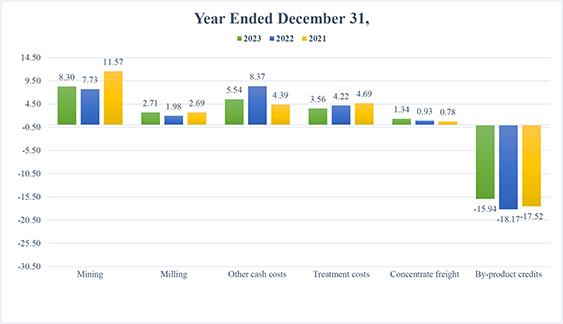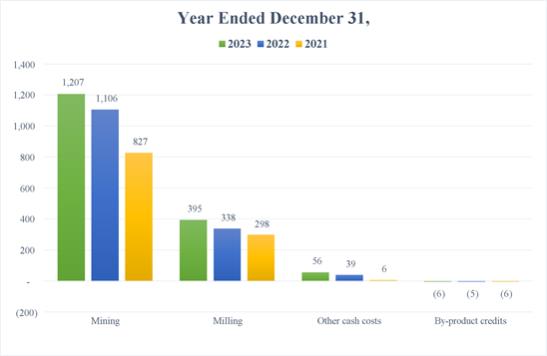In July 2018, the EPA informed Hecla Limited that it and several other PRPs may be liable for cleanup of the SMCB site or for costs incurred by the EPA in cleaning up the site. The EPA stated it has incurred approximately $9.6 million in response costs to date. On May 2, 2022, Hecla Limited received a letter from a PRP notifying Hecla Limited that three PRPs will seek cost recovery and contribution from Hecla Limited under CERCLA for certain investigatory work performed by the PRPs at the SMCB site. Hecla Limited cannot with reasonable certainty estimate the amount or range of liability, if any, relating to this matter because of, among other reasons, the lack of information concerning the site, including the relative contributions of contamination by the various PRPs.
Carpenter Snow Creek and Barker-Hughesville Sites in Montana
In July 2010, the EPA made a formal request to Hecla for information regarding the Carpenter Snow Creek Superfund site located in
Cascade
County, Montana. The Carpenter Snow Creek site is located in a historical mining district, and in the early 1980s Hecla Limited leased 6 mining claims and performed limited exploration activities at the site. Hecla Limited terminated the mining lease in 1988.
In June 2011, the EPA informed Hecla Limited that it believes Hecla Limited, and several other PRPs, may be liable for cleanup of the site or for costs incurred by the EPA in cleaning up the site. The EPA stated in the letter that it has incurred approximately $4.5 million in response costs and estimated that total remediation costs may exceed $100 million. Hecla Limited cannot with reasonable certainty estimate the amount or range of liability, if any, relating to this matter because of, among other reasons, the lack of information concerning the site, including the relative contributions of contamination by various other PRPs.
In February 2017, the EPA made a formal request to Hecla for information regarding the Barker-Hughesville Mining District Superfund site located in Judith Basin and Cascade Counties, Montana. Hecla Limited submitted a response in April 2017. The Barker-Hughesville site is located in a historic mining district, and between approximately June and December 1983, Hecla Limited was party to an agreement with another mining company under which limited exploration activities occurred at or near the site.
In August 2018, the EPA informed Hecla Limited that it and several other PRPs may be liable for cleanup of the site or for costs incurred by the EPA in cleaning up the site. The EPA did not include an amount of its alleged response costs to date. Hecla Limited cannot with reasonable certainty estimate the amount or range of liability, if any, relating to this matter because of, among other reasons, the lack of information concerning past or anticipated future costs at the site and the relative contributions of contamination by various other PRPs.
Lucky Friday and Keno Hill Environmental Issues
On July 12, 2022, our Lucky Friday mine received a notice of violation from the EPA alleging violations of the Clean Water Act between 2018 and 2021 relating primarily to concentration levels of zinc and lead in the mine’s permitted water discharges. Currently, the EPA has not initiated any formal enforcement proceeding against our Lucky Friday subsidiary. In civil judicial cases, the EPA can seek statutory penalties up to $59,973 per day per violation and, in administrative actions, the EPA can seek administrative penalties up to $23,989 per day per violation with a maximum administrative penalty of $299,989 for all alleged violations. The EPA typically pursues administrative penalties. At this time, we cannot reasonably assess the amount of penalties the EPA may seek, or predict the terms of any potential settlement with the EPA.
On December 14, 2023 and January 29, 2024, our Keno Hill mine received notice from the Yukon government that it is charged with violating the Quartz Mining Act and the Waters Act, two statutes of the Yukon Territory, relating to alleged violations of Keno Hill’s mining license and water license. The allegations are that the mine stored hazardous materials inconsistent with the terms of its mining license on or between April 19, 2022 and July 25, 2023 and exceeded water discharge limits in its water license on June 27 and December 6, 2023. If convicted, the maximum fine for an offense under both of these laws is $100,000 per offense. Because we are at the initial stages of this regulatory proceeding, we cannot reasonably predict the outcome of this matter at this time.
Litigation Related to Klondex Acquisition
On May 24, 2019, a purported Hecla stockholder filed a putative class action lawsuit in the U.S. District Court for the Southern District of New York against Hecla and certain of our executive officers, one of whom is also a director. The complaint, purportedly brought on behalf of all purchasers of Hecla common stock from March 19, 2018 through and including May 8, 2019, asserts claims under Sections 10(b) and 20(a) of the Securities Exchange Act of 1934 and Rule 10b-5 promulgated thereunder and seeks, among other things, damages and costs and expenses. Specifically, the complaint alleges that Hecla, under the authority and control of the individual defendants, made certain material false and misleading statements and omitted certain material information regarding Hecla’s Nevada
F-38


